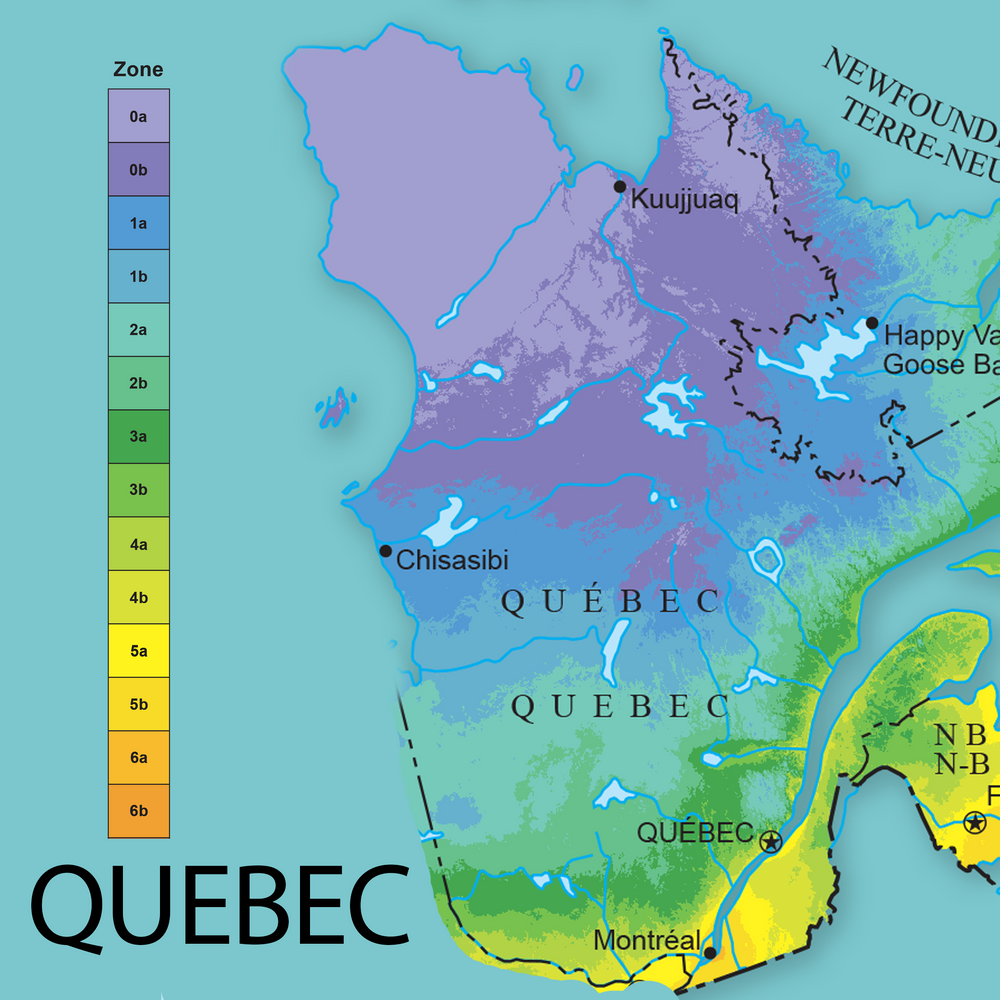Characteristics of Quebec Planting Region
Much of the region is subject to drastic temperature fluctuations throughout the year. Air masses bring on these conditions from both the north and south and sometimes result in severe weather. Aside from that, the province can be divided into three distinct climates.
1. Southern Quebec
The southern parts of the province experience a humid continental climate made up of four seasons. Summers generally range between warm to hot and humid, while winters are frigid with heavy snowfall. This area also has a significant amount of rainfall throughout the year.

Image from Natural Resources Canada
2. Central Quebec
This area of the province has a subarctic climate. The summers are typically warm and very short, whereas the winters are long, cold, and experience very heavy snowfall. The winters in this area of the country are some of the coldest in eastern Canada.

Image from Natural Resources Canada
3. Northern Quebec
The upper part of this region experiences an arctic climate characterized by long, icy winters and short, cool summers.

Image from Natural Resources Canada
Frost-free periods vary drastically across the province. For example, the city of Montreal has an average of 140 days without frost each year, while the northern region averages less than 80 frost-free days. Therefore, it’s best to search for the first and last frost dates for your specific location to maximize your growing time.
Challenges of Growing in Quebec
1. Short growing seasons
Across the province of Quebec, short planting seasons and long winters are the norm. With such a brief timeframe, it’s necessary to utilize indoor gardening to maximize your growing days.
2. Heavy snowfall
Abundant snowfall can be expected throughout the region, limiting the ability to extend your growing season into the winter. Therefore, indoor gardening or the use of protective coverings are essential to keep your garden alive and healthy in this area.
3. Temperature fluctuation
Drastic changes between hot and cold are a defining characteristic of this region. This restricts the variety of vegetables that can be grown outdoors as warm-season plants may struggle to survive when the temperature drops.

Spring in Saint-Jean-De-Matha; Québec | Photo by Alexis Mette on Unsplash
The Benefits of Using a Greenhouse in Quebec
A greenhouse is a perfect way to extend your growing season and protect your garden from heavy snow and ice in this region. Utilizing a greenhouse will also allow you to experiment with a wide range of different plants, including warm-season vegetables that may not survive outdoors throughout the province. Learn more about winter-friendly plants for your greenhouse.
1. Extend your Growing Season
-
Without a Greenhouse:
Quebec tends to experience a 2-4 month planting timeframe across the province. While the growing season becomes briefer the further north you are, most of the province is limited to cold-hardy vegetables that can survive the lower temperatures throughout the region.
-
With a Greenhouse:
Double or even triple your growing season by using a greenhouse! An extended season in this region can reach 7-9 months so you can enjoy delicious vegetables well into the cold winter months and explore the endless possibilities a greenhouse can offer.
Learn more about specific growing dates for your area and the best vegetables to plant in each part of Quebec.


Customer images of the Sungrow greenhouse in Farnham, Quebec


Customer images of the Sungrow greenhouse in Oka, Quebec
2. Grow a Wider Variety of Vegetables
-
Without a Greenhouse:
Due to Quebec’s short growing season and regular temperature fluctuations, it’s suggested to opt for cool-season vegetables that can survive throughout the colder conditions when outdoor growing. This includes the following:
- Turnips
- Lettuce
- Kale
- Cabbage
- Arugula
- Spinach
- Radishes
-
Peas
-
With a Greenhouse:
Greenhouse gardeners have countless options for vegetables they can grow in Quebec. While cold weather and short growing seasons may have limited planting possibilities before, a greenhouse will allow you to grow a variety of delicious vegetables without the need to transplant outdoors at a later date. Some of the most popular crops include:
- Beans
- Peppers
- Cucumber
- Squash
- Eggplant
- Tomato
- Carrot
- Chives
- Artichoke
- Garlic
- Celery
- Zucchini
- Shallots
- Chicory
- Sweet Corn
- Watermelon
- Cantaloupe
- Hot Peppers
- Green Pea
- Parsnip
- Leek
- Snow Pea
- Potato
- Chinese Cabbage
- Spanish Onion
-
Pumpkin

Indoor gardening | Photo by Aleksandra Boguslawska on Unsplash
Why Planta Greenhouses?
- Wind resistant up to 65 mph (learn more about how our greenhouses hold up in high-altitude climates).
- Withstands a snow load of up to 98 psf (480kg/square meter).
- Made with a heavy-duty galvanized steel frame.
- Polycarbonate panels provide 100% protection against UV rays.
- The Sungrow greenhouse is bell-shaped - allows the wind, snow, and hail to slide off the sides.
- Extendable (Sungrow, Sigma and Farmer models can be extended beyond 100ft)
- Made in Europe and are exclusively imported
- Maintenance-free

